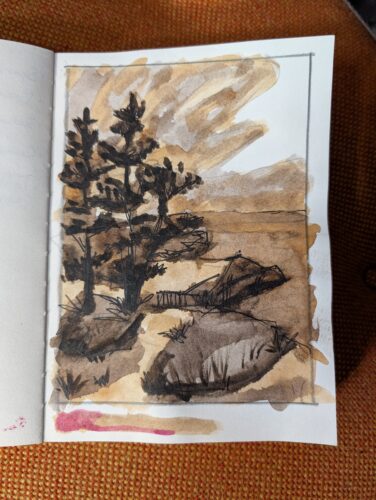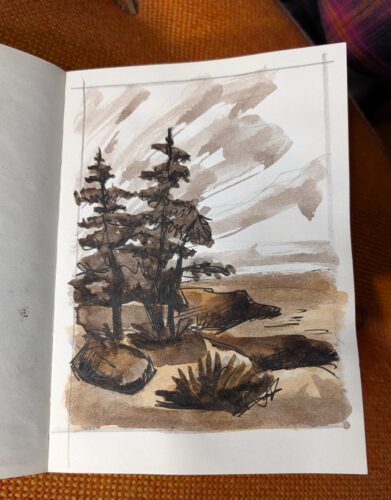I vividly remember seeing a real Van Gogh in person for the first time. The marks he made in his self portrait captured my attention. After that museum visit I did a deep dive into Van Gogh’s drawings and paintings- the thing that really unifies his work in my mind is the quality and quantity of his marks. Every mark unique and partially determined by his tools- from brushes to reed pens, his marks were all really interesting.
I have made vats of walnut ink, while not the ink Van Gogh would have used it has been forcing me to play with brushes and the marks the brushes make, particularly as I have tested casein medium/binder in the ink.
I have been using some old Strathmore 400 series drawing paper (90lb I believe) that I had ordered to make myself some books and then lost interest in the project. These pages were unearthed in the great basement studio cleanout. I cut the sheets in half to get 12×18 inch pieces of paper. These sheets are roughly the same aspect ratio as the photos I took this summer while on vacation. 
I’ve been working with these papers and my homemade inks to make studies of my images. I’ve also been making some mixed media pieces with the studies in mind. The interesting thing is that after I make a few studies of the image, I’m not looking too closely at the original photo, only checking in on it here and there, and occasionally never. I more rely on the studies, which work out the composition before I make the final art piece.
Anyway, I’ve been playing around with squirrel mop brushes and a few other soft brushes to create my images, and it’s been interesting to capture the marks these brushes make with the casein and walnut ink. The brush strokes very much lend to the sketch and the study. The layers of the casein based walnut ink give a lot of depth to the sketches.
I’ve also been mixing it up with these images. I’ve added in night blue Caran D’ache Neocolor 2, some blue Inktense, and some white chalk pastel. The walnut casein based ink mixes with the blues to create a lovely shade of warm gray that I’m ink love with. I mixed up some clear casein medium and have used that to further thin out the walnut casein ink and get even lighter lights.
The casein gives the paper a nice tooth for adding in the chalk pastel. I give the pastel a spray of SpectraFix to keep it from smudging.
In these images I’m attempting to capture the smoothness of the sandy shore line, the calm-ish water, and the rocky shore as well as the darkness of the trees and rose bushes.

The casein also dries to a lovely satin finish.































